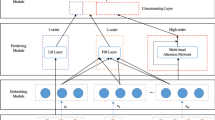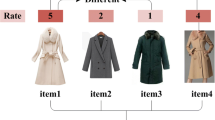Abstract
Click-through rate (CTR) is a positive feedback of user preferences or product purchases, and its small increase can bring huge benefits. Therefore, CTR prediction plays a key role in computing advertising and recommendation systems. Research shows that the accuracy of CTR prediction models is closely related to the input features. Existing related models usually focus on certain aspects of features, such as second-order interactions or temporal changes, and ignore the diversity of features. In this paper, a modular click-through rate prediction framework JointCTR is proposed. The framework integrates four types of prediction models, each of which learns different types of features, including original features, embedded features, interactive features, and sequential features. According to actual application scenarios, these models can be assembled or removed flexibly, and models of the same type can be replaced by each other. In order to avoid the impact of data diversity, sparsity, and high-dimensional features, an embedding layer is added to the framework to achieve unified embedding processing for different data types. To learn sequential behaviors, we propose a model SeqCTR based on the attention mechanism to capture the dynamics of user interests in the framework. To better learn high-order features, we apply HorderCTR proposed in our previous work to the framework to automatically identify high-value feature combinations. Extensive experiments on four public datasets show the effectiveness of the proposed framework, which yields competitive performance compared to state-of-the-art models (the AUC increases by + 0.24% on MovieLens-1 M and 0.85% on Criteo). Almost all different types of popular models can be assembled into it, that shows the flexibility and scalability of the framework.



Similar content being viewed by others
References
Guo W, Han J, Tang R, et al. (2019) Order-aware embedding neural network for CTR prediction. In: Proc. of the 42th International ACM SIGIR Conference on Research and Development in Information Retrieval
Ktena S I, Myana P K, Tejani A, et al. (2019) Addressing delayed feedback for continuous training with neural networks in CTR prediction. In: Proc. of the 13th ACM Conference on Recommender Systems (RecSys)
Bai X, Abasi R, Edizel B, Mantrach A (2019) Position-aware deep character-level CTR prediction for sponsored search. IEEE Trans Knowl Data Eng 33:1722–1736. https://doi.org/10.1109/TKDE.2019.2941881
Pan F, Li S, Ao X, et al. (2019) Warm up cold-start advertisements: Improving CTR predictions via learning to learn ID embeddings. In: Proc. of the 42th International ACM SIGIR Conference on Research and Development in Information Retrieval (RecSys)
Yang X, Deng T, Tan W, et al. (2019) Learning compositional, visual and relational representations for CTR prediction in sponsored search. In: Proc. of the 28th Conference on Information and Knowledge Management (CIKM)
Andrew G, Gao J (2007) Scalable training of L1-regularized log-linear models. In: Proc. of the 24th International Conference on Machine Learning (ICML)
He X, Pan J, Jin O, et al. (2014) Practical lessons from predicting clicks on ads at facebook. In: Proceedings of the 8th International Workshop on Data Mining for Online Advertising, (ADKDD) - in Conjunction with SIGKDD
Gai K, Zhu X, Li H, et al. (2017) Learning piece-wise linear models from large scale data for ad click prediction. arXiv:1704.05194
Rendle S (2011) Factorization machines with libFM. ACM Trans Intell Syst Technol 3(3):57
Juan Y, Zhuang Y, Chin W, et al. (2016) Field-aware factorization machines for CTR prediction. In: Proc. of the 10th ACM Conference on Recommender Systems (RecSys)
Yan C, Zhang Q, Zhao X, Huang Y (2017) An intelligent field-aware factorization machine model. In: Proc. of the 22nd International Conference on Database Systems for Advanced Applications (DASFAA)
He X, Liao L, Zhang H, et al. (2017) Neural collaborative filtering. In: Proc. of the 26th International World Wide Web Conference (WWW)
Qu Y, Cai H, Ren K, et al. (2016) Product-based neural networks for user response prediction. In: Proc. of the 16th IEEE International Conference on Data Mining (ICDM)
Cheng H, Koc L, Harmsen J, et al. (2016) Wide & deep learning for recommender systems. In: Proc. of the 1st Workshop on Deep Learning for Recommender Systems (DLRS) - in Conjunction with RecSys
Wang R, Fu G, Fu B, et al. (2017) Deep & cross network for ad click predictions. In: Proc. of the 2017 AdKDD and TargetAd - In Conjunction with ACM SIGKDD
Zhang W, Du T, Wang J (2016) Deep learning over multi-field categorical data - A case study on user response prediction. In: Proc. of the 38th European Conference on Information Retrieval (ECIR)
He X, Chua TS (2017) Neural factorization machines for sparse predictive analytics. In: Proc. of the 40th International ACM SIGIR Conference on Research and Development in Information Retrieval (SIGIR)
Guo H, Tang R, Ye Y, et al. (2017) DeepFM: A factorization-machine based neural network for CTR prediction. In: Proc. of the 26th International Joint Conference on Artificial Intelligence (IJCAI)
Li Z, Cui Z, Wu S, et al. (2019) Fi-GNN: Modeling feature interactions via graph neural networks for CTR prediction. In: Proc. of the 8th Conference on Information and Knowledge Management (CIKM)
Huang T, Zhang Z, Zhang J, et al. (2019) FiBiNET: Combining feature importance and bilinear feature interaction for click-through rate prediction. In: Proc. of the 13th ACM Conference on Recommender Systems (RecSys)
Yang Y, Shen S, Shen F, Zhao J et al (2020) Operation-aware neural networks for user response prediction. Neural Netw 121(1):161–168
Liu B, Yu J, Tang R, Guo H, Chen Y, Zhang Y, et al. (2019) Feature generation by convolutional neural network for click-through rate prediction. In: Proc. of 2019 World Wide Web Conference (WWW)
Wang R, Shivanna R, Cheng D Z, et al. (2020) DCN V2: Improved Deep & Cross Network for Feature Cross Learning in Web-scale Learning to Rank Systems. arXiv preprint arXiv:2008.13535
Vaswani A, Shazeer N, Parmar N, et al. (2017) Attention is all you need. In: Proc. of the Conference on Advances in Neural Information Processing Systems (NIPS)
Xiao J, Ye H, He X, et al. (2017) Attentional factorization machines: Learning the weight of feature interactions via attention networks. In: Proc. of the 26th International Joint Conference on Artificial Intelligence (IJCAI)
Zhou G, Fan Y, Yan Y, et al. (2018) Deep interest network for click-through rate prediction. In: Proc. of the 24th ACM SIGKDD International Conference on Knowledge Discovery and Data Mining
Song W, Duan Z, Xu Y, et al. (2019) AutoInt: Automatic feature interaction learning via self-attentive neural networks. In: Proc. of the 28th ACM International Conference on Information and Knowledge Management (CIKM)
Li H, Duan H, Zheng Y, Wang Q, Wang Y (2020) A CTR prediction model based on user interest via attention mechanism. Appl Intell 50(4):1192–1203
Wang Q, Liu F, Huang P et al (2020) A hierarchical attention model for CTR prediction based on user interest. IEEE Syst J 14(3):4015–4024
Polikar R (2006) Essemble based systems in decision making[J]. IEEE Circ Syst Mag 6(3):21–45
Hidasi B, Karatzoglou A, Baltrunas L, et al. (2016) Session-based recommendations with recurrent neural networks. In: Proc. of the 4th International Conference on Learning Representations (ICLR)
Song Y, Elkahky A M, He X (2016) Multi-rate deep learning for temporal recommendation. In: Proc. of the 39th International ACM SIGIR conference on Research and Development in Information Retrieval
Yu F, Liu Q, Wu S, et al. A dynamic recurrent model for next basket recommendation. In: Proc. of the 39th International ACM SIGIR conference on Research and Development in Information Retrieval, 2016
Zhou C, Bai J, Song J, et al. (2018) Atrank: An attention-based user behavior modeling framework for recommendation. In: Proc. of the 32nd AAAI Conference on Artificial Intelligence
Xiong C, Merity S, Socher R (2016) Dynamic memory networks for visual and textual question answering. In: Proc. of the 33rd International Conference on International Conference on Machine Learning (ICML)
Zhou G, Mou N, Fan Y, et al. (2019) Deep interest evolution network for click-through rate prediction. In: Proc. of the 33rd AAAI conference on Artificial Intelligence
Yan C, Chen Y, Wan Y, et al. (2020) Modeling low- and high-order feature interactions with FM and self-attention network. Appl Intell https://doi.org/10.1007/s10489-020-01951-6
Lian J, Chen Z, Zhou X, et al. (2018) xDeepFM: combining explicit and implicit feature interactions for recommender systems. In: Proc. of the ACM SIGKDD International Conference on Knowledge Discovery and Data Mining
Funding
This work was supported in part by Natural Science Foundation of Shanghai under Grant 19ZR1401900, and Shanghai Science and Technology Innovation Action Plan Project under Grant 19511101802.
Author information
Authors and Affiliations
Corresponding author
Additional information
Publisher’s note
Springer Nature remains neutral with regard to jurisdictional claims in published maps and institutional affiliations.
Rights and permissions
About this article
Cite this article
Yan, C., Li, X., Chen, Y. et al. JointCTR: a joint CTR prediction framework combining feature interaction and sequential behavior learning . Appl Intell 52, 4701–4714 (2022). https://doi.org/10.1007/s10489-021-02678-8
Accepted:
Published:
Issue Date:
DOI: https://doi.org/10.1007/s10489-021-02678-8




